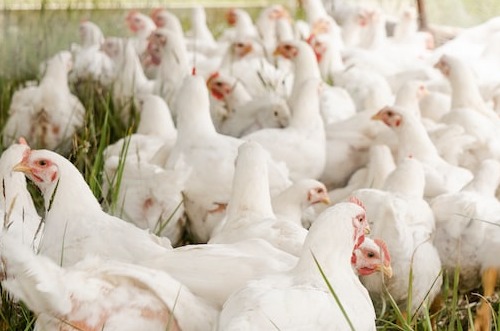W25: Chicken Update

In W25 in the chicken landscape, FAO expects global meat production in 2023 to reach approximately 364 million mt, an increase of less than 0.5% YoY, corresponding to an annual gross addition of only 1.3 million mt. Notably, chicken meat is expected to maintain its leading position in global production and expand its market share, accounting for 39.21% of the total forecast. This growth is attributed to the strong demand from the food service sector and the appeal of more affordable meat options. These positive trends persist despite the challenges posed by widespread outbreaks of highly pathogenic avian influenza and the high cost of feed in the industry. Global chicken and egg consumers are currently grappling with high prices due to various challenges in the poultry industry, including supply problems, diseases like bird flu, cost inflation, new regulations, government intervention, shifting consumer demand, and limited customer engagement. These factors have disrupted the supply chain, leading to significant price and supply fluctuations, and even empty shelves in some cases. Rabobank anticipates that global chicken and egg prices will remain relatively high throughout 2023, albeit lower on average than the levels observed in Q1-2023. Markets heavily impacted by bird flu, high costs, and regulatory changes are expected to experience particularly elevated prices. While prices may decrease in other markets, they are not likely to return to pre-2021 levels due to sustained high costs for feed, energy, and labor.
In W24, Brazilian fresh chicken meat exports per day (five working days) amounted to 17.48 thousand mt, down 35% compared to the previous 2 weeks of June. However, this decrease was not an actual retraction but a necessary adjustment to reflect reality, which was not accounted for in the initial survey conducted at the beginning of June. Taking this adjustment into account, in the first 11 working days of June-2023, the average daily shipment amounts to approximately 22.71 thousand mt, up 24% MoM, an increase of nearly 20% YoY, and slightly higher than the average recorded in the last 12 months. If the average export rate of W23 is maintained during the remaining two weeks of June, the total export volume for the month is projected to slightly surpass 475 thousand mt. Since Jan-2023, Brazilian chicken meat exports totals approximately 2.287 million mt, an increase of almost 3% compared to 2022’s first-half shipments, regardless of the final total for June-2023. The average price of Brazilian fresh chicken in June-2023 stands at USD 2,013.06/mt, surpassing USD 2 thousand/mt for the first time in 2023, and up 3% MoM but down 8.6% YoY.
In the first five months of 2023, chicken meat exports from the state of Paraná in Brazil reached slightly over 900 thousand mt, averaging just over 180 thousand mt. If this average is maintained, Paraná's poultry farming is set to exceed 1 million mt of chicken meat by the end of the first half of 2023, marking the first time such a milestone has been achieved in a single semester. In 2022, Paraná's exports in both semesters fell just short of 1 million mt, accumulating approximately 1.9 million mt. Standing alone in the top position, Paraná currently accounts for 42.5% of the total volume shipped and nearly 40% of the foreign exchange revenue generated by chicken meat in this period. In terms of volume, Paraná's share has increased by almost 2% compared to the first half of 2022. Among the 22 federative units that exported chicken meat in the first five months of 2023, only eight of them experienced a decline in both volume and value. While Amazonas saw a reduction in volume but an increase in value, Alagoas exhibited the opposite trend, with an increase in volume but a decrease in value. However, the most significant disparity between volume and value is observed in Pernambuco, where the shipped volume increased by just over 28%, while value grew by almost 280% YoY.
The USDA reports that during May-2023, US poultry in cold storage totaled 1.229 billion pounds, an increase of 9% YoY, with chicken reaching 825.43 million pounds, up 10% YoY. The USDA granted permits to two California-based companies, Upside Foods, and Good Meat, allowing them to sell lab-grown chicken meat made from live bird cells. Following recognition from the US Department of Health Food and Drug Administration as edible, these companies have received official approval to supply their products to supermarkets and restaurants. Lab-grown chicken meat is cultivated in steel tanks using live bird cells, fertilized eggs, or specialized "cell banks." The meat is shaped into traditional meat products such as cutlets, sausages, and fillet pieces during the production process. However, due to its high production cost, lab-grown meat is not expected to hit US store shelves on a large scale anytime soon. Currently, the Upside Foods plant in Emeryville can only produce 22mt of meat per year, while traditional US chicken production exceeds 22.6 million mt annually. In the near future, the companies intend to supply lab-grown chicken meat to only two gourmet restaurants in San Francisco and Washington.
Lastly, the chicken farming industry in Indonesia continues to face challenges concerning production efficiency. The sector faces the burden of high production costs resulting in higher prices for chicken products. Even large farms find it difficult to compete with chicken or broiler products from other countries, such as Malaysia, as Indonesian products remain comparatively more expensive. This discrepancy primarily arises from the industry's heavy reliance on imported feeds and the consequent escalation of feed prices.




